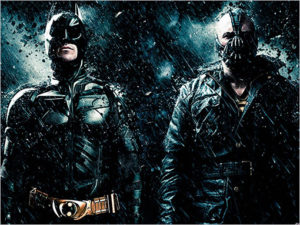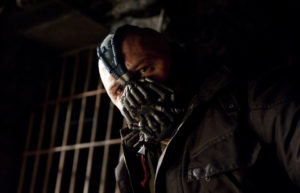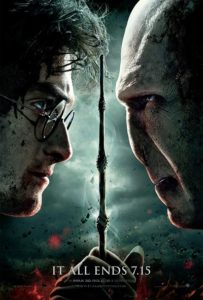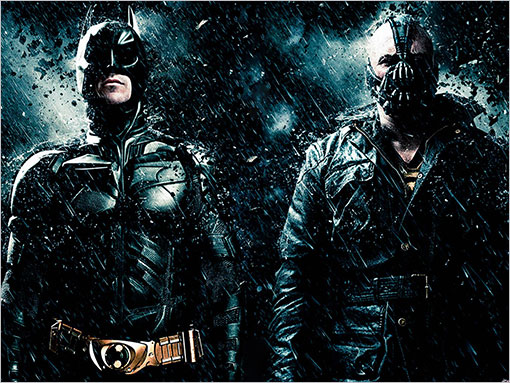The Spiritual Villain
In stories, the scariest villains are not the ones who kill the most, leer the most, or have the worst weapons. Instead the scariest villains have spiritual impact on the main characters, or we as readers and viewers.
Yes, we know they’re wrong. We certainly support their defeat. But deep down, we’re still forced to wonder, to consider the horrible prospect: maybe they’re right.
Maybe we really should introduce a little anarchy.
Maybe there is no good and evil, only power, and those with the will to seek it.
Maybe sins can never be forgiven, and the only justice is unequivocal punishment.
 You may recognize some of those quotes. The first is from The Joker of The Dark Knight (2008) fame. Many have remarked how The Joker compares with Bane, one of the main villains of the recently released The Dark Knight Rises film. That’s what gives rise to my thoughts today. Many have said that Bane doesn’t work as well as a villain, because The Joker was so iconically evil and Heath Ledger’s performance so unparalleled. Those could be two reasons. But I suggest Bane doesn’t work as well because he is not a spiritual villain.
You may recognize some of those quotes. The first is from The Joker of The Dark Knight (2008) fame. Many have remarked how The Joker compares with Bane, one of the main villains of the recently released The Dark Knight Rises film. That’s what gives rise to my thoughts today. Many have said that Bane doesn’t work as well as a villain, because The Joker was so iconically evil and Heath Ledger’s performance so unparalleled. Those could be two reasons. But I suggest Bane doesn’t work as well because he is not a spiritual villain.
Here is what I mean:
Great stories show good and evil for what they are, and the battle between them.
Greater stories make the strongest case they can for evil. Villainy is not simply “out there,” an external force in the antagonist. Instead it has a profound effect on either us, or the hero of the story, or best of all, both. Then, with that strong case made, evil is still defeated.
The greatest Story of all, of course, in Scripture and reality, makes the “best” possible case for evil across more than 2,000 pages and 66 books. Thus the final victory is even greater.
Now consider how recent film villains, and other stories’ villains, compare.
1. Bane, from The Dark Knight Rises.
 I don’t intend to fill this column with TDKR spoilers, yet some spoilers about Bane may be necessary here. This powerful mercenary, who survives on painkillers and growls in a sing-song, cultured and throbbing timbre, is clearly shown as evil. At least one character even tells him so. (Spoiler.) Eventually Bane’s plan nearly comes to fruition: his terrorists attack Gotham City, taking it hostage, and nearly destroy the metropolis. (Heavier spoiler.) He also easily defeats Batman in battle, casts him into prison, and vows to make him suffer.
I don’t intend to fill this column with TDKR spoilers, yet some spoilers about Bane may be necessary here. This powerful mercenary, who survives on painkillers and growls in a sing-song, cultured and throbbing timbre, is clearly shown as evil. At least one character even tells him so. (Spoiler.) Eventually Bane’s plan nearly comes to fruition: his terrorists attack Gotham City, taking it hostage, and nearly destroy the metropolis. (Heavier spoiler.) He also easily defeats Batman in battle, casts him into prison, and vows to make him suffer.
Never once did I as a viewer wonder, even for seconds, if Bane had the upper hand — not only physically but spiritually over Batman, and by proxy also over us.
Not once, even during French Revolution-inspired scenes (don’t compare it to “Occupy Wall Street” and so elevate that notion, or imply the story’s inspiration isn’t more timeless) did I even slightly suspect: You know, this sort of thing is inevitable. Maybe we should roll with it.
The Dark Knight Rises shows Bane’s evil, but doesn’t try to make the strongest case for it.
By contrast …
2. The Joker, from The Dark Knight.
 The Joker is axiomatically evil. Unlike Bane, he has no backstory. As explored in this feature, he comes from nowhere, causes chaos, and wants only to “watch the world burn.” Beyond that, viewers may suspect that he is right. What can any hero do against such reckless hate? You can’t appeal to his motives, because his motive is chaos and anarchy. You can’t bargain or negotiate. You can only wage war, while also fighting that same instinct in yourself: the instinct that maybe it’s all for naught, the instinct that there’s no point in fighting.
The Joker is axiomatically evil. Unlike Bane, he has no backstory. As explored in this feature, he comes from nowhere, causes chaos, and wants only to “watch the world burn.” Beyond that, viewers may suspect that he is right. What can any hero do against such reckless hate? You can’t appeal to his motives, because his motive is chaos and anarchy. You can’t bargain or negotiate. You can only wage war, while also fighting that same instinct in yourself: the instinct that maybe it’s all for naught, the instinct that there’s no point in fighting.
(At least one person, as we tragically saw Friday, followed through with this evil desire — imitating The Joker while rejecting the theme of good triumphing over such evil.)
Unlike Bane, The Joker has a spiritual effect on viewers, making his defeat more significant.
3. The evil thing from A Wrinkle in Time.
 Yes, I’ll keep reading Madeleine L’Engle’s works, because many have promised they do get better, in style if not in substance. But based on the first book’s evil thing (see, I can’t even remember the name of that villainous, Star Trek: The Original Series-like God-like Entity), I’m not expecting much more worst-case-for-evil, visceral villainy that is spiritual.
Yes, I’ll keep reading Madeleine L’Engle’s works, because many have promised they do get better, in style if not in substance. But based on the first book’s evil thing (see, I can’t even remember the name of that villainous, Star Trek: The Original Series-like God-like Entity), I’m not expecting much more worst-case-for-evil, visceral villainy that is spiritual.
In Wrinkle, the evil thing did evil by controlling people, not by appealing to their evil inner natures. Again we spy the trope: “evil is mainly outside yourself, not within yourself.” Objection 1: that is not a Biblical concept. Objection 2: it makes for mediocre storytelling.
So when the Evil Thing is defeated, by the Power of “Love” — e.g., of sentimentality — the victory rings hollow. Only a malevolent Outside Source is put down. Our own evil lives on.
By contrast …
4. Lord Voldemort from Harry Potter.
 The Dark Lord would not be nearly as interesting and spiritual a villain if he did not have such links with Harry Potter himself. I won’t go into spoilers, for those who haven’t yet read the series — and they really should, for Rowling, despite whatever faith she holds, fleshes out very Christian and redemptive concepts more powerfully than L’Engle in her Wrinkle-y theology. Yet by the end of the whole Harry Potter story, it’s revealed that Harry is not only fighting an evil villain outside himself, but is fighting a part of himself as well. Voldemort’s evil is not only external, but internal, with strong temptation: He could be right. Harry might give in. And we, fighting along with Harry, are forced to consider the same possibilities.
The Dark Lord would not be nearly as interesting and spiritual a villain if he did not have such links with Harry Potter himself. I won’t go into spoilers, for those who haven’t yet read the series — and they really should, for Rowling, despite whatever faith she holds, fleshes out very Christian and redemptive concepts more powerfully than L’Engle in her Wrinkle-y theology. Yet by the end of the whole Harry Potter story, it’s revealed that Harry is not only fighting an evil villain outside himself, but is fighting a part of himself as well. Voldemort’s evil is not only external, but internal, with strong temptation: He could be right. Harry might give in. And we, fighting along with Harry, are forced to consider the same possibilities.
Voldemort is one of the best spiritual villains — even above other famous dark lords such as Darth Vader, or even Sauron. Yes, those are also evil, but you rarely suspect they have a powerful religious, philosophical case to make for their actions that could overwhelm us.
Lesser evils
Here I’m also thinking of Inspector Javert, from Victor Hugo’s Les Misérables. How do Javert and other villains, have spiritual effects on a story’s heroes, and/or us?
How else do other villains, such as Bane from The Dark Knight Rises, function mainly as external, non-spiritual and therefore not as evil or threatening antagonists?
Before ending my words in lieu of your own, I must say one more word about the Aurora, Colorado suspect’s shooting of 12 people, 20 minutes into The Dark Knight Rises’s midnight premiere. People keep wanting to make the “real” villain “external” — Hollywood, guns and gun laws, the Tea Party, Occupy Wall Street, etc. Why this insistence that all other Things must be villainized — anything except humans’ evil nature itself?











































This is a phenomenal post. I will be thinking about spiritual villains as they occur in both fiction and real life for a long time to come.
I have to disagree with Bane being a non-spiritual villain, though I agree that though The Dark Knight’s Joker was my least favorite (no disrespect intended to the late Heath Ledger), he was perhaps the most profound villain of the trilogy. My explanation is spoiler-ridden so anyone who hasn’t seen the movie may wish to see the movie first before reading my argument.
Bane’s takeover of Gotham is where he really comes out as a “spiritual” villain. He holds the city hostage with a nuclear bomb and announces that he will release the city “to the people,” understanding that when given the chance people’s natural inclination is toward evil. And the majority of people in Gotham do indulge in their carnal desires. They condemn to death those they feel deprived them of their desires and “needs.” People steal from each other, the strong prey on the weak. When Selina Kyle witnesses a mob taking over a home, she says “this was someone’s home.” Her young tag-along says, “It’s the people’s home.”
When given the choice, we have all done evil (Romans 3:23), and only a few of us repent and follow Jesus down the narrow path (Matthew 7:14). Likewise, the masses in The Dark Knight Rises choose to do evil while a heroic remnant stand strong.
For me, though, the true villain Talia al Gul–Bane fully embraced her message, but she was the real mastermind, coming to finish her father’s work. (But I’m biased, ever since I heard rumors that she would make appearance, I waited with anticipation to see if it were true, and I wasn’t let down…and I admit I felt wonderfully geeky when I recognized her braided profile before other people gasped in the theatre when she announced herself). She and her father Ra’s are rightly indignant at the evils and injustices in the world, but they return evil for evil, seeking destructive measures to achieve the balance they seek. This time instead of tearing apart the city by gassing the city into fear-inducing toxins, Talia simply gives the city over to vices by removing the established order to prove how evil Gotham really is before she wipes it off the face of the earth with an atomic detonation.
I think that in recognizing humankind’s evil nature, The Dark Knight Rises echoes Romans 1: 21-32: “Because that, when they knew God, they glorified him not as God, neither were thankful; but became vain in their imaginations, and their foolish heart was darkened. Professing themselves to be wise, they became fools,And changed the glory of the uncorruptible God into an image made like to corruptible man, and to birds, and fourfooted beasts, and creeping things.Wherefore God also gave them up to uncleanness through the lusts of their own hearts, to dishonour their own bodies between themselves:Who changed the truth of God into a lie, and worshipped and served the creature more than the Creator, who is blessed for ever. Amen.For this cause God gave them up unto vile affections: for even their women did change the natural use into that which is against nature:And likewise also the men, leaving the natural use of the woman, burned in their lust one toward another; men with men working that which is unseemly, and receiving in themselves that recompence of their error which was meet.And even as they did not like to retain God in their knowledge, God gave them over to a reprobate mind, to do those things which are not convenient; Being filled with all unrighteousness, fornication, wickedness, covetousness, maliciousness; full of envy, murder, debate, deceit, malignity; whisperers, Backbiters, haters of God, despiteful, proud, boasters, inventors of evil things, disobedient to parents, Without understanding, covenantbreakers, without natural affection, implacable, unmerciful: Who knowing the judgment of God, that they which commit such things are worthy of death, not only do the same, but have pleasure in them that do them.”
Batman, however, sought to save what little good remained in Gotham, and even saved the skin of those that had so shamefully indulged in their selfish wickedness. When looking at people that we place more highly on our scale of evil, it is easy to be like the al Guls and see nothing there to save. But Jesus died for them just the same. (Note: I’m not promoting a universalist message, as Jesus died for all but most reject him).
As for not comparing Gotham’s anarchy to Occupy Wall Street…honestly, as a historian and a conservative, I compared it to both. While there are differences, the Occupy movement has parallels to the French Revolution–people had disdain for anyone that had more than they had and demand entitlements.
Here’s where I, along with Andy, must delve into the nitty-gritty of the film. So, just as Andy said, spoilers ahead. That’s my only spoiler: that there are spoilers ahead.
At this I would ordinarily agree in theory. But this is where the film’s limitations come into play: the story did not do well in setting up this pent-up inclination toward evil. That’s why the whole French Revolution / “Occupy” setup didn’t affect me as much, unless I imported a slow story building from the outside.
I will add specifics: we needed to see people complaining about the Batman’s crimes before he vanished, and lauding the supposed martyrdom of Harvey Dent, but also simultaneously leaning toward the very anti-system beliefs the Joker represented. Then when Bane comes along, that evil would find an outlet. But as one reviewer (I believe it was Jeffrey Overstreet) already noted, no revolutionary would start with such obvious ploys of evil as blowing up a football stadium and bridges. Instead he would have blown up the “right” targets: the stock exchange, for example, or Wayne Tower, or some supposed symbol of the “oppressor.” Perhaps the story originally included such details, and decided to pull back on them. In this case, attempted subtlety masked the clear themes they had hoped to convey.
Regardless, any buildup of the populace’s discontent would have had to fit with canon. In fact, long before Harvey Dent was revealed to have done anything, The Dark Knight showed that “common grace” was still alive and well in Gotham. Given the Joker’s “social experiment,” two ferries full of people, both regular citizens and condemned prisoners, refused to detonate the other. Batman’s faith that not all people are as depraved as the Joker is proven right, and for the first time, we see the Joker actually shocked that his latest anarchy ploy did not work. Rewarding!
I appreciated that moment, but felt it would have more poignant with the context I mentioned above. Usually in such stories, evening-news-style excerpts, perhaps man-on-the-street footage either in the film itself or on TV-in-the-film, is a good “cheat” for this (The Dark Knight used both to great effect, to show Batman’s and the Joker’s effects on the populace). I’m not sure why TDKR didn’t do similarly.
That part I did appreciate, yet again, I felt I had to “import” those beliefs from outside to make up for the film’s lack of context. The story should stand on its own.
Which theoretically should have made sense; however, I felt she lacked motivation. If anything, she could have been as “spiritual” a villain as Ra’s al Guhl, yet we did not get much about why Finishing Her Father’s Legacy was so important to her. I am familiar with this trope mainly from her character in Batman: The Animated Series, but even there she was a more-conflicted character and showed signs of truly loving Bruce Wayne. By contrast, the film’s presentation of their tryst had very little context and motive, and her “turning bad” by the end was unpredictable only because I had (falsely) trusted Nolan not to opt for something so predictable!
Brief aside: wasn’t there a misstatement early on that she was not Talia al Guhl?
Yes, and you need to carry that over from the first film. She never re-states it, does she? (Maybe I simply missed it. I was, after all, a little jittery throughout the film; I couldn’t kept keeping my mind on the exit door, two rows down and to the right.)
Originally I thought Bane’s attack on the stock exchange was the first part of a slow buildup to his “revolution.” The dialogue between the police officer (I keep my paper money at home) and the stockbroker (if the exchange goes down and we lose ours, even yours won’t be worth anything anyway!) could have reinforced this, but instead came off as isolated, even an agenda moment. (It’s an agenda with which I can agree, but it remained isolated from Bane’s main plan to attack Gotham City.)
Agreed and amen times ten, brother. Yet I ask: which film and which villain showed this more effectively, without needing to import from Scripture: The Dark Knight with The Joker, or The Dark Knight Rises with Bane? I recall so many Christians coming to exactly the wrong conclusions about the Joker, aghast at how insulting and “unrealistic” it was to portray a human being as so evil. Yet others were drawn to contemplate how evil we can truly be. I’m unsure Rises will have that same effect. Only the real-life Colorado theater shootings may have that effect.
Ground that I felt the first film covered very well, anyway. Perhaps that is why TDKR sort of left it “assumed,” and why that story aspect seemed unsupported.
Oh, I didn’t mean to imply I reject any and all comparisons. What I mean is that any OWS comparisons must be qualified, as that fake “movement” began after TDKR had already been scripted and was in production. It elevates that “cause” to compare the film’s antagonists only to OWS, without exploring the real-life and more-consistent anarchist “revolutionary” movements that preceded it.
I think that’s why makes the wrongly-defined-“justice” and wrongly-defined-“freedom” elements of Les Mis so enduring: they’re grounded in history, yet refer to timeless extreme beliefs. And yet even The Incredibles, I believe, dealt more effectively with the notion of “the common people” trying to tear down the extraordinary people, out of envy and false notions of “democracy.” (But perhaps C.S. Lewis, in his short satirical essay Screwtape Proposes a Toast, did it best.)
Bane, and the scriptwriters behind him, could have taken a page from both those stories to make his rhetoric more tempting, and more “spiritual.” We need not just to see his evil, but be forced to reckon with it — and then, with our hero, defeat it.
In the old Unbreakable movie, there’s an interesting quote about the two kinds of villains.
“But he says there’s always two kinds; there’s the soldier villain – who fights the hero with his hands; and then there’s the real threat – the brilliant and evil archenemy – who fights the hero with his mind.”
All villains break down into those two categories. You could easily rephrase them into physical/spiritual, hands/mind.
I think point 3 suffers from a shallow reading of A Wrinkle in Time. The real villain in the story is the vacuum inside Meg’s soul. She sees herself as a non-entity, a sort of gray blur that no one could ever love or find in any way unique or special. IT (aka “the evil thing”) is the physical manifestation of this mindset.
IT’s power isn’t so much mind control as seduction of the will. IT confirms everything Meg has ever believed about herself. Why should she fight it? Give in to IT, and you become part of the ultimate self. You never have to feel like a misfit again. You never have to think for yourself again. It’s so much easier to simply submit to IT and allow your will and identity to be subsumed. Nothing remains except obedience to IT.
If that’s not a summation of spiritual, Satanic evil, I don’t know what is. It’s the inverse of submission to God’s will and immersion in God’s love, which heals us, completes us, and makes us precisely who we were created to be. Meg gains the upper hand when she makes the leap from self-focused longing to be loved to self-sacrificial loving. I think the love expressed at the climax runs much deeper than sentiment. Her triumph over IT is also a victory over the seed of that same evil that’s been lurking invisibly within her. She’s still a work in progress, but she’s come a long way.
L’Engle can be maddening. Her writing is often uneven, awkwardly plotted, and rife with discontinuities, but there are many passages that are jaw-droppingly beautiful. She’s like the girl with the curl in the middle of her forehead: “…when she was good, she was very, very good, but when she was bad, she was horrid.” I’ve always thought of her more as a prose poet than a novelist.
It’s easy to flog her for her universalist sentiments, but I confess I have more patience with someone who takes an overly-generous view of God’s mercy vs. His justice than with someone more concerned that everyone who deserves it gets thoroughly cooked.
I don’t see the “purple” tendancies you mention in L’Engle, but I agree with your assessment of it.
[…] friend read this on Facebook Monday afternoon; it was posted by E. Stephen Burnett (whose excellent post on spiritual villains can be read at Speculative Faith), who was quoting another […]
Ursula Le Guin makes no claim to be a Christian, but her A Wizard of Earthsea revolves around a struggle between Ged and himself.
From Fred:
Perhaps I’d have to read it again, yet that’s not how I read it. The IT was the evil thing, again mainly outside her. It was defeated by the Power of Love, or rather, a much more shallow version of it that consisted mainly of saying “I love you.” (By contrast, other stories more clearly show the self-sacrificial part of Biblical love.)
To be honest, this reader found her that way. 🙂 I suppose, then, the author did what she wanted, yet there is a balance between presenting a character as realistically hopeless/angsty or even sinful, and presenting a character as dull and uninteresting.
This is where I believe the story could have been much better. The fact is, from my recent reading I recall nothing attractive being shown about IT’s manipulations. There was no pull, there was no convincing “argument” from IT or the narrative that IT might be right all along. This is a shame, because now that you mention it, that would have made the final victory much more spiritual and significant.
You should have written A Wrinkle in Time, Fred.
My main point is that I would have to import those themes from outside the story and help it along. Until now I hadn’t thought of trying to interpret the story that way, but it was you, not L’Engle or the story itself, who gave the interpretation. Yes, subtlety is good, but in this case the theme was not merely subtle, but muddled.
That’s what other friends have said, and why I plan to keep reading.
… Which I hope I didn’t do here. You’re right, the topic is rather too easy, and I took care of my thoughts on that back in the previous column.
I can understand that. Maybe one’s leaning is founded in one’s spiritual background. Growing up, I was exposed to little of either universalism or hellfire-and-brimstone, and so today feel little need to lean one way or the other. Both extremes bother me, as they are both distant from Scripture’s emphasis on both God’s wrath and mercy.
Heh–I was “poking the bear” a little with my reply, Stephen, I suppose in part because I was wondering if your perception of the author might be tinting your perception of the story.
I think you have to give L’Engle credit for strongly affirming the reality of an evil tainting the entire universe, a concept that was rapidly falling out of fashion in the early sixties, when this story was written. IT is only a tiny part of that, and Meg’s battle a small skirmish in a vast spiritual war fought on battlefields ranging from the microscopic to the intergalactic, internal and external. This theme is expanded and elaborated in the next book, A Wind in the Door.
Perhaps, but again, the true victory for Meg was reaching beyond the focus on herself and her perceived inadequacies that was strangling her. The visible battle with IT mirrors her own interior struggle. Yes, L’Engle is painting with crayon here, but for her audience, that simple “I love you” to the weird little brother who’d multiplied the difficulty of Meg’s life was a breakthrough that carried a ton of emotional weight. One does not lightly utter those three words in middle school, even today. I think it’s also important to note that Meg doesn’t win with her intellect, the single aspect of herself she takes pride in, where she thinks her strength lies.
I also think it’s important to keep L’Engle’s stories in context. Many of her books are young-adult stories written in the early sixties. You’re not going to get a lot of complex subtext, and parts will seem very naive, especially compared to more recent fare. A Wrinkle in Time is written from the POV of a middle-school-age “nerd girl,” and it wasn’t a very cool thing to be one at that time. This story resonated with a lot of girls at a very vulnerable point in their lives, and some of the issues in the story that seem trivial to you and me were huge for them.
Trust me, I would have fouled it up beyond all recognition.
We’ve talked before about the way stories are a partnership between reader and author. Both sides bring something to the table, the synthesis is greater than the sum of the parts, and different readers are going to walk away with different experiences. It’s like one of those hidden-picture games. You’re going to see things right away that are invisible to me, and vice-versa, and there’s nothing wrong with that.
I think L’Engle is also a good example of a Christian who writes, as opposed to a writer of Christian fiction. I think we have to be careful of expecting more than she’s offering here.
Tor.com has an excellent series of articles on Madeleine L’Engle’s novels, both spec-fic and mainstream, and you can access them all here: http://www.tor.com/features/series/the-madeleine-lengle-reread